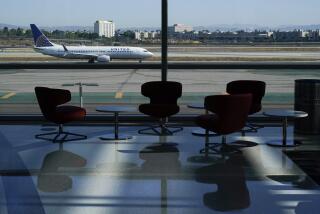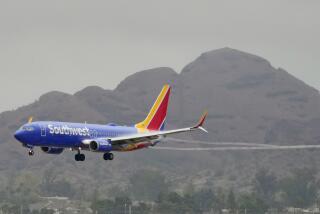Southwest Trims Flights on Some of Its Busiest Routes
- Share via
Southwest Airlines, which resisted the airline industry’s scaling back of operations in the month since the terrorist attacks, said Thursday that it plans to slightly pare its schedule, effective Oct. 28.
But the low-fare giant said the cuts, which amount to less than 1% of its capacity, aren’t directly related to the drop-off in passenger traffic since the attacks, nor are expected to be the first phase of a prolonged reduction in its schedule.
Rather, Southwest said it had to reduce flights on some of its most frequent routes to have enough airplanes to start its planned service out of Norfolk, Va., and some other new nonstop flights, said spokeswoman Brandy King. No cities will lose service, she added.
The Dallas-based airline otherwise would be short of jetliners, because it deferred delivery of 11 new planes and retired three others in response to the Sept. 11 attacks. Southwest flies only Boeing 737s.
“This is a unique situation,” King said. “We had expanded our operations, but unfortunately had to restrict our number of aircraft. We need this [change] to fulfill our schedule.”
Among the cuts: Southwest will trim its daily flights from Burbank to Oakland to 14 from 15, and from Burbank to Phoenix to six flights from seven. The number of daily flights from Los Angeles International Airport to Oakland will drop to 22 from 24, and the Ontario-to-Oakland daily schedule will drop to 13 flights from 14, King said.
The biggest concentration of cuts, about 10%, will occur in Southwest’s Dallas-to-Houston service.
Since the attacks, Southwest maintained its unique reputation by refusing to join other major U.S. airlines in slashing its operations by 20% or more and in laying off thousands of employees. Southwest did so despite acknowledging that, like the other carriers, it’s been losing money since Sept. 11. And Southwest has said it’s leaving all of its options open, which could mean more schedule cuts ahead.
Moody’s Investors Service downgraded its rating of Southwest’s senior unsecured debt Thursday because it expects the airline “will experience a protracted period of weak earnings and cash flow” that wasn’t previously reflected in its credit ratings.
But Southwest, with about $1.6 billion in cash on hand and a strong balance sheet, “is the best-positioned airline to withstand the current economic uncertainties,” Moody’s said.
Meanwhile, Southwest also filed to raise as much as $1 billion in securities sales over time. In a filing with the Securities and Exchange Commission, Southwest said it plans to sell debt or asset-backed securities on terms to be decided later.
King said “it’s too early to tell” if Southwest will seek to back any part of those sales with the loan guarantees now available to the airlines under the recently approved $15-billion federal bailout of the industry.
Southwest also said it plans to equip its 355 airplanes with plastic restraints similar to handcuffs starting Nov. 1, as carriers step up security efforts in response to the attacks.
“The vendor had been chosen and the type of restraint,” said Linda Rutherford, another Southwest spokeswoman. “Our plan was to have this all in place by the end of the year. The events of Sept. 11 did cause us to accelerate getting the restraints on board the airplanes.”
Southwest also created a new position to oversee security, naming Greg Wells, who was director of flight dispatch, to the post of vice president of safety, security and flight dispatch.
*
Bloomberg News was used in compiling this report.
More to Read
Inside the business of entertainment
The Wide Shot brings you news, analysis and insights on everything from streaming wars to production — and what it all means for the future.
You may occasionally receive promotional content from the Los Angeles Times.











